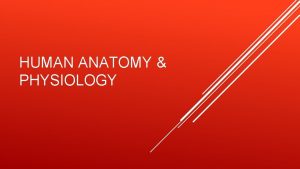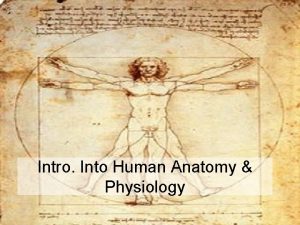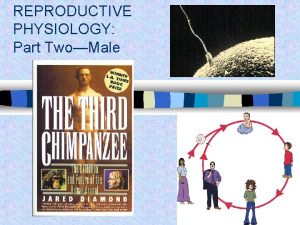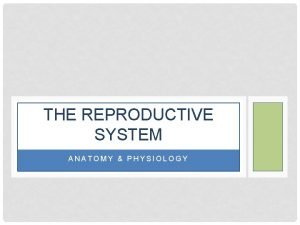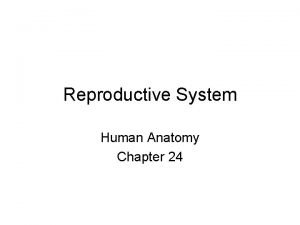Chapter 2 Human Reproductive Anatomy and Physiology The
















- Slides: 16

Chapter 2 Human Reproductive Anatomy and Physiology

The Male • Hormonal changes begin between 10 and 16 years of age • Outward changes – Penis and testes increase in size – Grows taller, more muscular – Secondary sex characteristics • Pubic and facial hair • Deeper voice • Changes occur because of Testoseterone – Primary male sex hormone

The Female • Development of breasts occurs first • First menstrual period (menarche) occurs approximately 2 to 2. 5 years later (around 11 to 15 years of age) • Growth spurt ends earlier than the male • Hips broaden • Pubic and axillary hair appear

Male Genitalia • Penis – Deposit sperm into female’s vagina • Semen may be secreted during sexual intercourse before ejaculation • Scrotum – Sac that contains the testes – Suspended from the perineum – Helps keeps testes cooler than the rest of the body – Constant increase in temp around testes can prevent spermatogenesis and lead to permanent sterility – Necessary for spermatogenesis – Sperm production • Testes – Manufacture male germ cells • Spermatozoa or sperm – Secrete male hormones (androgens)

Testosterone • Has the following effects, not related to sexual reproduction – – – Increase muscle mass and strength Promotes growth of long bones Increases basal metabolic rate (BMR) Enhances production of RBCs Produces enlargement of vocal cords Affects the distribution of body hair

Uterus • Hollow muscular organ – Fertilized ovum implants and develops into an embryo • Shaped like an upsidedown pear • Lies between the urinary bladder and rectum, above the vagina • Supported by the following ligaments – – Broad Round Cardinal Uterosacral • Autonomic nerve supply • Not under voluntary or conscious control

Uterus (cont. ) • Cervix (neck or lower part of uterus) • Consists of cervical canal with an internal opening near uterine corpus (internal os) • Opening into vagina (external os) • Mucosal lining has four functions – Lubricates vagina – Acts as a bacteriostatic agent – Provides alkaline environment to shelter deposited sperm – Produces a mucus plug in cervical canal during pregnancy

Ovaries • Two Functions: – Production of hormones • Estrogen and progesterone – Stimulation of an ovum’s maturation during each menstrual period • At birth, every female has all the ova that she will have throughout her reproductive years (around 2 million) • By adulthood, number is in the thousands • By climacteric (menopause), the ovum no longer respond to hormonal stimulation to mature

Types of Female Pelves • • Gynecoid most favorable for vaginal delivery Anthropoid may deliver vaginal Android is typical male pelvis Platypelloid is unfavorable for vaginal delivery

True and False Pelves • False pelvis – Supports the enlarging uterus – Guides fetus into true pelvis • True pelvis – Dictates the bony limits of the birth canal

Pelvic Outlet • The coccyx can move or break during the passage of the fetal head, but an immobile coccyx can decrease the size of the pelvic outlet and make vaginal birth difficult • Problems that can cause a pelvis to be small: – – History of pelvic fracture Rickets Immobile coccyx Indicate that delivery by cesarean section will be necessary

Breasts • Accessory organs of reproduction – Produce milk after birth • Provides nourishment for the infant • Provides maternal antibodies to infant • Montgomery’s glands – Small sebaceous glands – Secrete a substance to lubricate and protect breasts during lactation • Is there any relation between breast size and ability to breast feed?

Female Reproductive Cycle

Female Reproductive Cycle (cont. ) • Ovulation – Mature ovum released from follicle about 14 days before onset of menstrual period – Secretes increased quantities of progesterone to prepare the uterine lining for a fertilized ovum • Menstruation – Progesterone and estrogen levels decrease • Causes endometrium to break down • Clots are not normally seen in menstrual discharge – Menarche – the first menstrual period (11 -15 years) – Menopause – the final menstrual period

Physiology of the Male & Female Sex Act • Male – Sperm can reach fallopian tubes within 5 minutes – Can remain viable in female for up to 4 to 5 days • Female – The egg lives for only 24 hours after ovulation – Sperm must be available during that time for fertilization to occur

Elsevier items and derived items © 2011, 2007, 2006 by Saunders, an imprint of Elsevier Inc. 16
 Chapter 2 human reproductive anatomy and physiology
Chapter 2 human reproductive anatomy and physiology Chapter 1 introduction to human anatomy and physiology
Chapter 1 introduction to human anatomy and physiology Anterior posterior distal proximal
Anterior posterior distal proximal Human anatomy and physiology seventh edition marieb
Human anatomy and physiology seventh edition marieb Holes essential of human anatomy and physiology
Holes essential of human anatomy and physiology Uterus perimetrium
Uterus perimetrium Anatomy and physiology ninth edition
Anatomy and physiology ninth edition Chapter 14 anatomy and physiology
Chapter 14 anatomy and physiology Anatomy and physiology chapter 8 special senses
Anatomy and physiology chapter 8 special senses Chapter 13 anatomy and physiology of pregnancy
Chapter 13 anatomy and physiology of pregnancy Anatomy and physiology chapter 2
Anatomy and physiology chapter 2 Chapter 7 anatomy and physiology
Chapter 7 anatomy and physiology Art labeling activity: figure 14.1 (3 of 3)
Art labeling activity: figure 14.1 (3 of 3) Chapter 10 blood anatomy and physiology
Chapter 10 blood anatomy and physiology Anatomy and physiology chapter 15
Anatomy and physiology chapter 15 Necessary life functions anatomy and physiology
Necessary life functions anatomy and physiology Holes anatomy and physiology chapter 1
Holes anatomy and physiology chapter 1
























